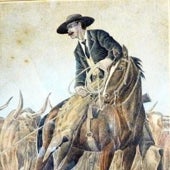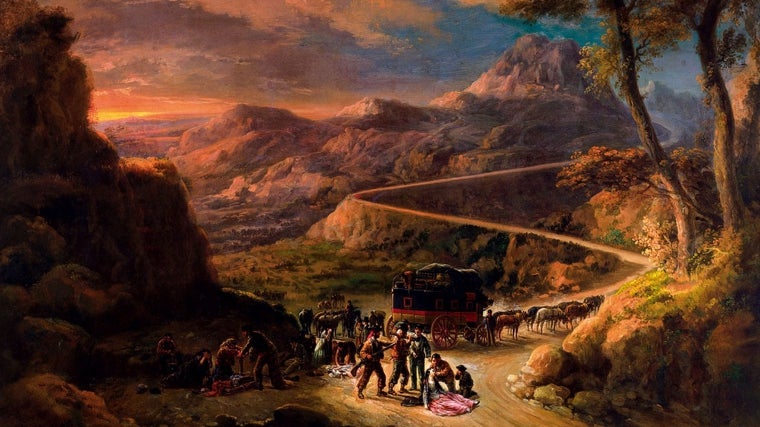The cowboys' journey: from the Guadalquivir Marshes to the Great Plains

"And is that really how it happened?" Marshal Wyatt Earp was asked about the true history of the West. And he, who had earned his fame in the brilliant Gunfight at the O'K Corral, replied: "Exactly that's how it was, more or less a lie." From a young age, when the wild spirit of the conquest of the West reigned, he had been successively or simultaneously a buffalo hunter and owner of brothels and gambling halls, but, over the years, a sheriff's star was planted in his heart at the same pace as the United States appropriated the lands leading to the Pacific coast, which for centuries had been provinces of Spain (Louisiana, New Mexico, and California).
In his later years, beginning in the second decade of the 20th century, the emeritus Earp, an old defender of the law who had been born when the law was uncertain beyond the Mississippi, strolled through the primitive Hollywood studios, inspiring John Ford, who greeted him as if Saint John the Baptist had come to the film set.
The West, as a destination for dreams and hallucinations, oscillates between the preservation of a primitive Eden (the plenitude afforded by the contemplation of sublime nature) and the never-satisfied desire of fiercely human ambition, which disrupts paradise with populous cities and the arrival of the railroad. From James Fenimore Cooper's novel The Last of the Mohicans to Peckinpah's twilight films, where the automobile already appears.
The pursuit of wealth is the fate of a man of action: there's always purer gold and new lands to possess. If there aren't any, you dream about them.
Miguel Ángel Blanco, a scholar of the Spanish legacy in the American West, recalls that the word 'illusion' in English "means delirium or mirage," and it was the first explorers in the service of the Crown who felt the overwhelming attraction of the legendary cities of gold.
From Juan Ponce de León's arrival in Florida in 1513, passing through Menéndez de Avilés' Fountain of Eternal Youth, until the early decades of the 19th century, Spain governed some two-thirds of the current continental landmass of North America. Throughout the 16th century, men led by Vázquez de Coronado, first, and by Juan Oñate, in the later decades of that century, traveled on horseback through present-day Western territories; the Llano Estacado, where tornadoes raged, and New Mexico, the birthplace of the Pueblo Indians.
It is the first encounter in history between the knight and the virginal and menacing landscapes of the West. And so, the eyes of López de Cárdenas from Extremadura discover the Grand Canyon, and Sergeant Major Zaldívar delivers a drawing of a buffalo, a work now preserved in the General Archive of the Indies.
Reading 'Spanish Horses and Equines in the Conquest and Colonization of America' by Justo del Río, one understands that the Spanish gentleman has transferred to the cowboy values that identify him with the American spirit: a sense of honor, a thirst for greatness, the defense of a cause or an ideal, hospitality, and courtesy. "The soldier felt an attraction to frontier life, a consequence of a culture that exalted the act of war as the highest social value. The horse is an instrument for war and peace, an offensive and defensive weapon, and it helps to explain, in itself, life and how to preserve it. The horse is a mechanism for social advancement, a means of transportation, and a way of working."
From the end of the 15th century, originating in Andalusia, the first cattle ranches developed in America. The arrival of equestrian knowledge and the development of riding and taming techniques in the heart of the American West coincided with the popularity of chivalric novels. Don Quixote himself humorously instructs Sancho, urging him to behave dignifiedly on horseback as Governor of the Island of Barataria: "When you mount your horse, do not throw your body over the rear saddle, nor carry your legs stiff and drawn away from the horse's belly, nor ride so limply that you seem to be riding a donkey: for riding makes some gentlemen, others stablemen."

As Morales Padrón, the unforgettable professor of History of Geographical Discoveries, noted, "in the shadow of famous figures, captains and rulers, there were individuals with unknown faces, herding herds of pigs, sheltering chicks, carrying newborn animals on stretchers or pampering seeds to achieve the miracle of their taking root."
For those who have a thirst for adventure, this territory as vast as the sea presents man with the same challenge: to master the immensity.
"Many of the explorers were livestock entrepreneurs, and a significant amount of the funds invested in the formation and equipment of the troops that departed from Spain came from that activity and returned to it," writes Justo del Río, referring to the cattle ranchers and cowboys.
In this way, a cattle-raising society was formed, adapted to the western territories, whose skills and knowledge were transmitted from New Spain and the Iberian Peninsula. "The horses' heads, necks, and chests were covered with headdresses, the sides girded, and the hips and legs covered with thick escabillas to protect them from the natives' arrows. These believed they were fighting immortal centaurs." In 'The Legacy of Spain in America,' José Tudela notes: "It was believed that the horses ate iron or gold, and when they were found to be feeding on grass, their animal nature was revealed."
 abc
abc
As the 19th century progressed, notable landscape painters joined the explorations of the West, sometimes linked to cartography, other times to industry—which needed to know how to profit from new lands—or simply out of artistic curiosity. Albert Bierdstadt, Frederick Remington, William Ranney, and others contributed fascinating images of Yosemite , Yellowstone , and the relationship between cowboys and Native Americans. In this back-and-forth relationship between America and Spain, also during that same period of the 19th century, notable Romantic painters such as Eugenio Lucas, Genaro Pérez Villaamil, and Manuel Barrón offered works that share a motif and focus with the West, such as "Assault on a Stagecoach" (1850) or "View of Puerto de Miravete, Old Road to Madrid" (1869). Looking out at the Atlantic Ocean , the outlaw is compared to the bandit and his location in the Andalusian mountains. Veterans of the American Civil War and the Spanish War of Independence, without a clear destiny, were the seed of these two figures, the outlaw and the bandit. The paintings we are referring to belong to the Thyssen Museum collection and have been complemented, since the emergence of photography, by large images of natural landscapes by artists such as William Henry Jackson ('Devil's Tower', 1892, Library of Congress) and others, such as Edward S. Curtis, who focused on preserving the memory of Native American tribes ('An Oasis in the Badlands', 1905). Throughout the 20th century, the Mexican draftsman José Cisneros, based in El Paso, completed the evolution of vaquero and vaquero figures in hundreds of works.
Before cinema, literature provided material for the mystification of the "cowboy," who originally—and already during the time of the US expansion into California—was simply a country boy with the hard task of pulling a horse for days and nights. The word "vaquero" derives from the English word "buckaroo," but the usage is for "cowboy." Many of the authors who gained fame writing about the West never visited it, such as the German Karl May. In Spain, Marcial Lafuente Estefanía delivered a short Western novel a week for years and eventually published more than 2,500. When it comes to the West, the brazen Wyatt Earp told the truth: "That's exactly the History of the West, with a few more lies, a few less lies."
ABC.es





%3Aformat(jpg)%3Aquality(99)%3Awatermark(f.elconfidencial.com%2Ffile%2Fbae%2Feea%2Ffde%2Fbaeeeafde1b3229287b0c008f7602058.png%2C0%2C275%2C1)%2Ff.elconfidencial.com%2Foriginal%2Fdaf%2F8be%2Ff59%2Fdaf8bef59d7203bca091781ca9b15c99.jpg&w=1280&q=100)